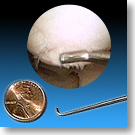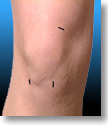
The Arthroscopic Surgery Center at Southern California Orthopedic Institute is designed to provide our patients with comprehensive education about arthroscopic surgery and exceptional care through the combined knowledge, experience, and expertise of our specialty-trained surgeons.
Welcome to our Arthroscopic Surgery Center
 Our surgeons integrate all aspects of specialized care by collectively combining their knowledge, experience, and expertise as the foundation of the Arthroscopic Surgery Center at Southern California Orthopedic Institute.
Our surgeons integrate all aspects of specialized care by collectively combining their knowledge, experience, and expertise as the foundation of the Arthroscopic Surgery Center at Southern California Orthopedic Institute.
Our specialty-trained orthopedic surgeons have dedicated their practices to this specialized field of study. With their commitment to continued education through attending courses, lecturing, writing, and actively learning the newest procedures and techniques, our surgeons are some of the most highly skilled arthroscopy surgeons in the area.
Arthros copy has revolutionized the treatment of joint injuries. In the past, treatment of orthopedic injuries involved extensive surgery, including large incisions, a hospital stay, and a prolonged recovery period. But today, with the help of an arthroscope, orthopedic surgeons can easily examine, diagnose, and treat problems in the joint that previously may have been difficult to identify. The arthroscope is a small fiber optic viewing instrument made up of a tiny lens, a light source, and a video camera.
copy has revolutionized the treatment of joint injuries. In the past, treatment of orthopedic injuries involved extensive surgery, including large incisions, a hospital stay, and a prolonged recovery period. But today, with the help of an arthroscope, orthopedic surgeons can easily examine, diagnose, and treat problems in the joint that previously may have been difficult to identify. The arthroscope is a small fiber optic viewing instrument made up of a tiny lens, a light source, and a video camera.
The surgical instruments used in arthroscopic surgery are very small (only 3 or 4 mm in diameter) but appear much larger when viewed through an arthroscope. Shown at right—both as it appears on the operating table and when viewed arthroscopically—is a probe, used for examination of internal structures (in this case the underside of a patella, or kneecap).
 The surgeon inserts the arthroscope into the joint through a tiny incision (about 1/4 of an inch) called a portal. Two or three incisions may be made for portals. Other portals are used for the insertion of surgical instruments, such as the probe shown above. Typical incision sites and sizes for knee arthroscopy are shown at left. These incisions result in very small scars which in many cases aren't even noticeable.
The surgeon inserts the arthroscope into the joint through a tiny incision (about 1/4 of an inch) called a portal. Two or three incisions may be made for portals. Other portals are used for the insertion of surgical instruments, such as the probe shown above. Typical incision sites and sizes for knee arthroscopy are shown at left. These incisions result in very small scars which in many cases aren't even noticeable.
With small incision sites and direct access to most areas of the joint, an arthroscopic surgeon can diagnose and surgically correct a vast array of joint problems like arthritis and ligament tears.
 For example, almost any region of the knee may be treated arthroscopically. A normal meniscus—shown at left—seen through the arthroscope appears as a smooth, white wedge-shaped structure. The video clip below shows a brief portion of an arthroscopic meniscal repair. Arthroscopic surgery is not limited to the knee: also common is arthroscopy of the shoulder, ankle, wrist, elbow, and hip.
For example, almost any region of the knee may be treated arthroscopically. A normal meniscus—shown at left—seen through the arthroscope appears as a smooth, white wedge-shaped structure. The video clip below shows a brief portion of an arthroscopic meniscal repair. Arthroscopic surgery is not limited to the knee: also common is arthroscopy of the shoulder, ankle, wrist, elbow, and hip.
Patient Consultation
The Arthroscopic Surgery Center at Southern California Orthopedic Institute provides our patients access to consultation Monday through Friday.
Prior to your consultation, new patients will be asked to complete forms, which include medical history as well as demographic and insurance information. This information, along with any current diagnostic imaging (X-ray, CT, MRI), will be utilized by your doctor to help in your diagnosis and treatment plan.
To schedule an appointment with one of our Arthroscopic Surgery Center surgeons, please call (818) 901-6600, or complete the appointment request box.
Please visit our comprehensive surgery preparation section for tips and information on preparing for your surgery.Preparing for My Surgery
To learn more about a specific condition or treatment, please use the appointment request box or call
(818) 901-6600.Request an Appointment















